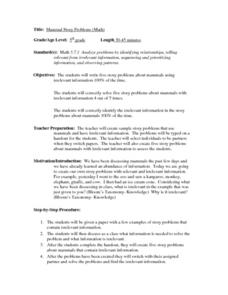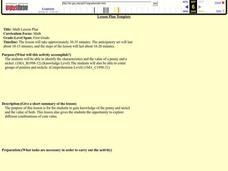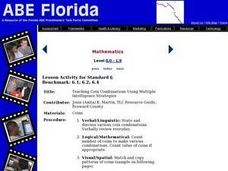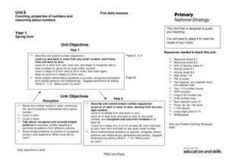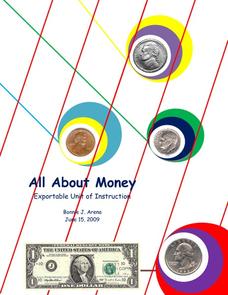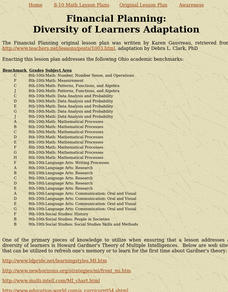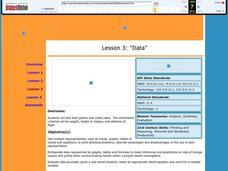Curated OER
The Sum of Our Integer Intelligences
Young mathematicians explore integers. They review adding integers through engaging in mathematical labs. Each lab station is designed to reflect one of the multiple intelligences. Resources for all activities are provided.
Curated OER
The Greedy Dog
Teach young mathematicians the concepts of greater than, less than, and equal to with kinesthetic, visual, verbal, and numeric approaches. In a playful session that addresses multiple intelligences, your class will: dramatize a greedy...
Curated OER
Westward Ho-- With Multiple intelligences
Students acquire knowledge and literacy (through multiple intelligences) in social studies, language arts, science and math as we study the Oregon Trail. This type of lesson is strong in its attempt to be accessible to all learners.
Curated OER
Mammal Story Problems (Math)
Fifth graders, after discussing the teacher's handout examples, practice writing five story problems about mammals using relevant/irrelevant information. As a class, they solve the story problems while identifying the key concepts that...
Curated OER
Math Lesson Plan
The students will be able to identify the characteristics and the value of a penny and a nickel. The students will also be able to count groups of pennies and nickels. The lesson uses multiple intelligences.
Curated OER
Teaching Coin Combinations Using Multiple Intelligence Strategies
Sixth graders engage a multiple intelligence instructional activity with the intention of teaching probability. The instructional activity is standards based and the needed materials are few. The flipping of a coin is done and the data...
Curated OER
What's Your Favorite Planet?
Fourth graders, after listing the nine planets and their differences, choose one planet as their favorite. From the information acquired on each students favorite planet, they make a graph illustrating their favorites and then transform...
Curated OER
Counting, Properties of Numbers, and Reasoning about Numbers
Five days of lessons develop number sense and counting patterns, including odd and even numbers, 5s and 10s, doubles, and ways to make 10. Each session opens with fun finger play to reinforce counting and reasoning about numbers. Various...
Curated OER
How Many?
Establish 1:1 correspondence by counting students, first one gender, then the other. Give each child a colored cube (one color for boys, another for girls) and have small groups determine more or less and how many all together. As a...
Curated OER
Multiple Variables in an Equation
Young mathematicians apply problem-solving skills to equations that have more than one variable. They will work through the process to problem solve and discover the solution.
Curated OER
All About Money
Few topics engage young mathematicians as much as learning about money. Through a series of shared readings and hands-on activities, children explore the US currency system, learning how to count money and calculate change as they create...
Curated OER
Using 10 to Subtract
Pictures of 10-frames help young mathematicians complete 4 subtraction equations with numbers up to 20. This is a resource that just might help subtraction across 10 "click" for your visual learners. They cross out objects from the...
University of Kansas
Newspaper in the Classroom
Newspapers aren't only for reading—they're for learning skills, too! A journalism unit provides three lessons each for primary, intermediate, and secondary grades. Lessons include objectives, materials, vocabulary, and procedure, and...
Curated OER
Creating a Universally Designed Lesson Plan
Students investigate plant cells. In this multiple intelligences instructional activity, students engage in a variety of activities to foster an understanding of plant cells and how they work. Students read, write, observe, and role-play...
Curated OER
Writing up Math in English
Seventh graders review the steps in writing a math problem. They write story problems stating the situation, the problem to be solved, explaining the process used to solve the problem, and state the answer. Students view a PowerPoint...
Curated OER
Financial Planning
Young scholars participate in activities in order to apply the skills of sound financial planning that includes creating and maintaining a budget. The lesson is intended for diverse learners because of the application of The Multiple...
Curated OER
What is Probability?
Students participate in a variety of activities in order to understand the concept of probability. The students are engaged because of the application of The Multiple Intelligences Theory.
Curated OER
Data
Students collect data from an experiment they perform. In this data lesson, students use multiple representations to solve practical problems; describe advantages and disadvantages of the use of each representation. Then, they evaluate...
Curated OER
Multiple Intelligences Holistic Plan
Ninth graders apply basic algebra concepts to equations using cognitive, affective, and kinesthetic components. They create their own word problem, perform the story problem using a dramatic presentation, and present the problem to the...
Curated OER
Finding Areas of Triangles, Rectangles, and Circles
Students find the areas of geometric shapes. In this geometry lesson students find and measure the sides, perimeters, and areas of quadrilaterals, triangles, and circles. Students relate the measures to the others by using formulas.
EduGAINs
Data Management
Using a carousel activity, class members gain an understanding of the idea of inferences by using pictures then connecting them to mathematics. Groups discuss their individual problems prior to sharing them with the entire class....
Curated OER
Y-Intercept and Slope Intercept Form
Alegebra amateurs identify the slope and the y-intercept given a linear equation in slope-intercept form by correctly completing some in class problems. They write the linear equation in slope-intercept form that corresponds to the given...
Learner
Solid Shapes
A collection of two lessons, kindergartners will identify two-dimensional shapes in solid shapes. They will develop basic knowledge of the components that make up a sphere, rectangular prism, pyramid, cylinder, cone, and cube. Young...
Curated OER
Changes in the Community: Diversity of Learners Adaptation
Students determine the rate of travel through Ohio based on mode of transportation: walking, horse bak riding, railroad, and car. They are asked to write a sentence explaining how they would determine how long each trip takes. Students...



